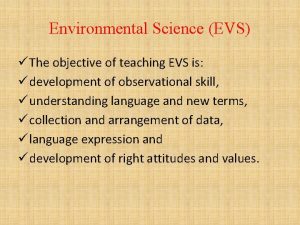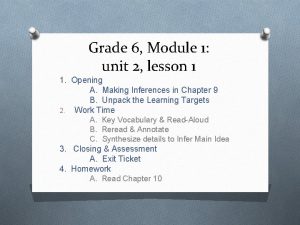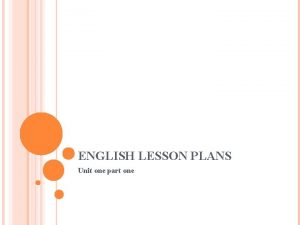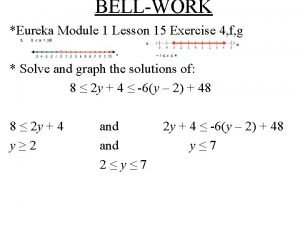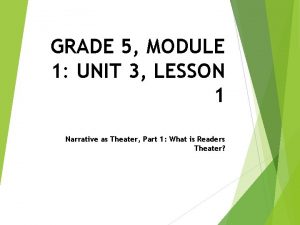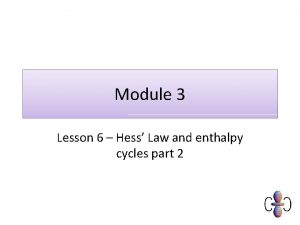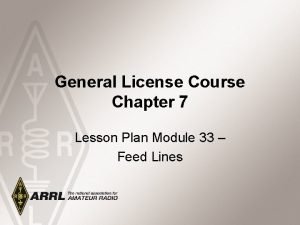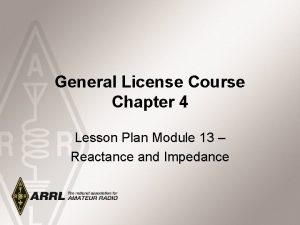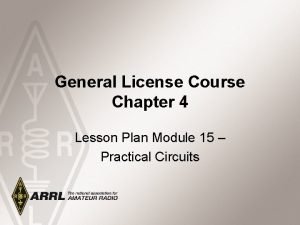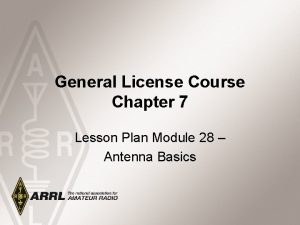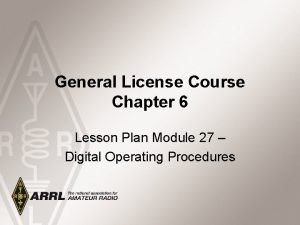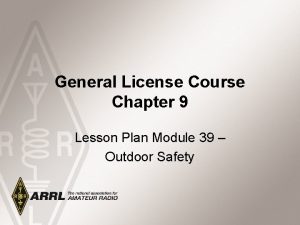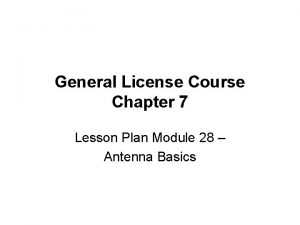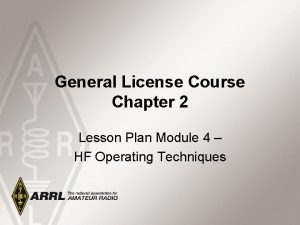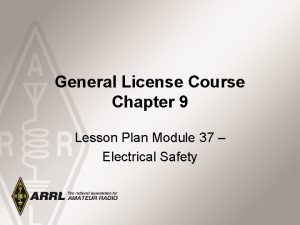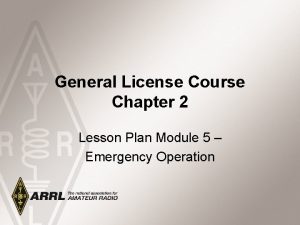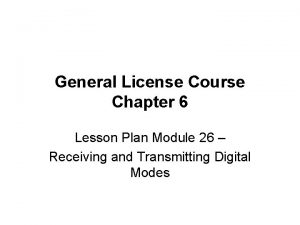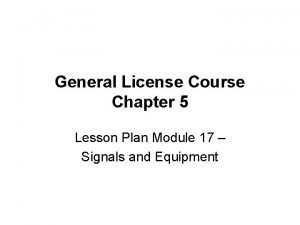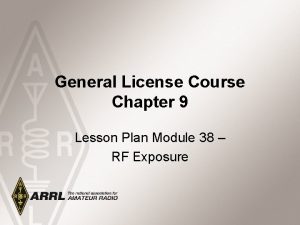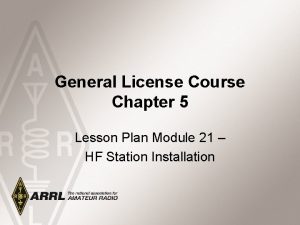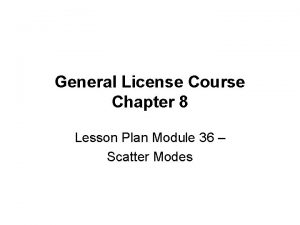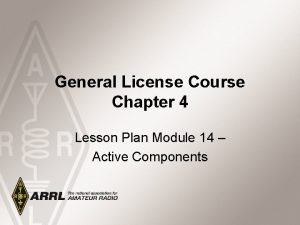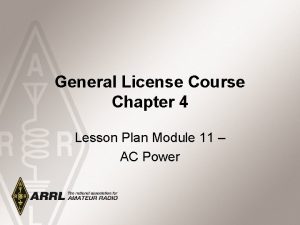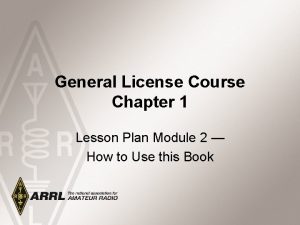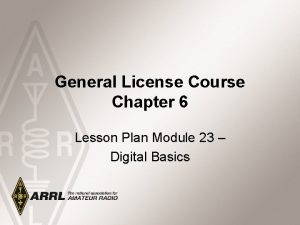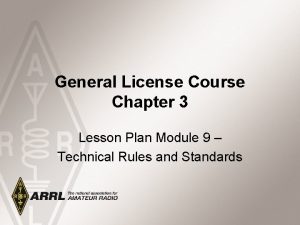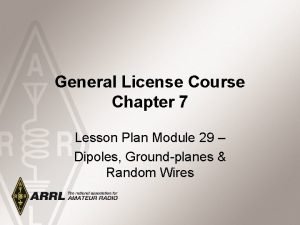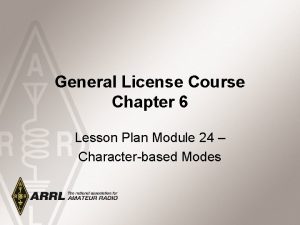General License Course Chapter 7 Lesson Plan Module
































- Slides: 32

General License Course Chapter 7 Lesson Plan Module 30 – Yagi Antennas

How Yagis Work • Yagi – the most popular directional antenna • Yagi antennas reduce interference: signals, noise from unwanted directions • Rear and sides by more than 20 d. B • The Yagi is an array antenna with multiple elements • Array antennas create a maximum field strength in a specific direction (main or major lobe) 2015 General License Course 2

How Yagis Work • Yagi elements: • Driven – element connected to the feed line • Parasitic – one or more elements not connected to the feed line that influence the antenna’s radiated and receive pattern • Parasitic arrays – energy from the driven element induces a current to flow in the parasitic elements which is reradiated as part of the antenna’s total signal 2015 General License Course 3

Yagi Structure & Function • A Yagi antenna has a driven element and at least one parasitic element • Driven element – about the same as a resonant dipole • Director elements – reinforce signals in a single main lobe (shorter than the driven element) • Reflectors – cancel signals to the rear (longer than the driven element) • Front-to-back ratio is the ratio of signal strength at the peak of the radiation pattern’s major lobe to that in exactly the opposite direction 2015 General License Course 4

Yagi Structure • The simplest Yagi is a twoelement antenna with a driven element (DE) and either a reflector (usually) or a director. • DE is approx. a λ/2 dipole • Reflector element is about 5% longer than the driven element and placed behind the DE by 0. 15 -0. 2 λ • Director element is about 5% shorter than the driven element and placed ahead of the DE by 0. 15 -0. 2 λ 2015 General License Course 5

Design Tradeoffs • Primary element design variables: length, spacing along the boom, thickness • Placement and length of the elements affects gain, tuning, and pattern • Longer boom with a fixed number of directors increases gain • Larger diameter elements reduces SWR and increases SWR bandwidth • Antenna modeling software used to optimize the antenna design 2015 General License Course 6

Impedance Matching • Many Yagi designs have a feed point impedance of 20 -25 ohms requiring matching • Gamma matching is a popular technique • Section of parallel conductor transmission line using the driven element as one of its conductors • A mechanical advantage - the driven element doesn’t have to be insulated from the boom • Tuning by adjusting length of the transmission line or a series capacitor 2015 General License Course 7

Practice Questions 2015 General License Course

Which HF antenna would be the best to use for minimizing interference? A. A quarter-wave vertical antenna B. An isotropic antenna C. A directional antenna D. An omnidirectional antenna G 2 D 11 2015 General License Course

Which HF antenna would be the best to use for minimizing interference? A. A quarter-wave vertical antenna B. An isotropic antenna C. A directional antenna D. An omnidirectional antenna G 2 D 11 2015 General License Course

Which of the following would increase the bandwidth of a Yagi antenna? A. Larger diameter elements B. Closer element spacing C. Loading coils in series with the element D. Tapered-diameter elements G 9 C 01 2015 General License Course

Which of the following would increase the bandwidth of a Yagi antenna? A. Larger diameter elements B. Closer element spacing C. Loading coils in series with the element D. Tapered-diameter elements G 9 C 01 2015 General License Course

What is the approximate length of the driven element of a Yagi antenna? A. 1/4 wavelength B. 1/2 wavelength C. 3/4 wavelength D. 1 wavelength G 9 C 02 2015 General License Course

What is the approximate length of the driven element of a Yagi antenna? A. 1/4 wavelength B. 1/2 wavelength C. 3/4 wavelength D. 1 wavelength G 9 C 02 2015 General License Course

Which statement about a three-element, singleband Yagi antenna is true? A. The reflector is normally the shortest element B. The director is normally the shortest element C. The driven element is the longest element D. Low feed point impedance increases bandwidth G 9 C 03 2015 General License Course

Which statement about a three-element, singleband Yagi antenna is true? A. The reflector is normally the shortest element B. The director is normally the shortest element C. The driven element is the longest element D. Low feed point impedance increases bandwidth G 9 C 03 2015 General License Course

Which statement about a three-element, singleband Yagi antenna is true? A. The reflector is normally the longest element B. The director is normally the longest element C. The reflector is normally the shortest element D. All of the elements must be the same length G 9 C 04 2015 General License Course

Which statement about a three-element, singleband Yagi antenna is true? A. The reflector is normally the longest element B. The director is normally the longest element C. The reflector is normally the shortest element D. All of the elements must be the same length G 9 C 04 2015 General License Course

How does increasing boom length and adding directors affect a Yagi antenna? A. Gain increases B. Beamwidth increases C. Front to back ratio decreases D. Front to side ratio decreases G 9 C 05 2015 General License Course

How does increasing boom length and adding directors affect a Yagi antenna? A. Gain increases B. Beamwidth increases C. Front to back ratio decreases D. Front to side ratio decreases G 9 C 05 2015 General License Course

What configuration of the loops of a two-element quad antenna must be used for the antenna to operate as a beam antenna, assuming one of the elements is used as a reflector? A. The driven element must be fed with a balun transformer B. There must be an open circuit in the driven element at the point opposite the feed point C. The reflector element must be approximately 5 percent shorter than the driven element D. The reflector element must be approximately 5 percent longer than the driven element G 9 C 06 2015 General License Course

What configuration of the loops of a two-element quad antenna must be used for the antenna to operate as a beam antenna, assuming one of the elements is used as a reflector? A. The driven element must be fed with a balun transformer B. There must be an open circuit in the driven element at the point opposite the feed point C. The reflector element must be approximately 5 percent shorter than the driven element D. The reflector element must be approximately 5 percent longer than the driven element G 9 C 06 2015 General License Course

What does “front-to-back ratio” mean in reference to a Yagi antenna? A. The number of directors versus the number of reflectors B. The relative position of the driven element with respect to the reflectors and directors C. The power radiated in the major radiation lobe compared to the power radiated in exactly the opposite direction D. The ratio of forward gain to dipole gain G 9 C 07 2015 General License Course

What does “front-to-back ratio” mean in reference to a Yagi antenna? A. The number of directors versus the number of reflectors B. The relative position of the driven element with respect to the reflectors and directors C. The power radiated in the major radiation lobe compared to the power radiated in exactly the opposite direction D. The ratio of forward gain to dipole gain G 9 C 07 2015 General License Course

What is meant by the “main lobe” of a directive antenna? A. The magnitude of the maximum vertical angle of radiation B. The point of maximum current in a radiating antenna element C. The maximum voltage standing wave point on a radiating element D. The direction of maximum radiated field strength from the antenna G 9 C 08 2015 General License Course

What is meant by the “main lobe” of a directive antenna? A. The magnitude of the maximum vertical angle of radiation B. The point of maximum current in a radiating antenna element C. The maximum voltage standing wave point on a radiating element D. The direction of maximum radiated field strength from the antenna G 9 C 08 2015 General License Course

Which of the following is a Yagi antenna design variable that could be adjusted to optimize forward gain, front-to-back ratio, or SWR bandwidth? A. The physical length of the boom B. The number of elements on the boom C. The spacing of each element along the boom D. All of these choices are correct G 9 C 10 2015 General License Course

Which of the following is a Yagi antenna design variable that could be adjusted to optimize forward gain, front-to-back ratio, or SWR bandwidth? A. The physical length of the boom B. The number of elements on the boom C. The spacing of each element along the boom D. All of these choices are correct G 9 C 10 2015 General License Course

What is the purpose of a gamma match used with Yagi antennas? A. To match the relatively low feed point impedance to 50 ohms B. To match the relatively high feed point impedance to 50 ohms C. To increase the front-to-back ratio D. To increase the main lobe gain G 9 C 11 2015 General License Course

What is the purpose of a gamma match used with Yagi antennas? A. To match the relatively low feed point impedance to 50 ohms B. To match the relatively high feed point impedance to 50 ohms C. To increase the front-to-back ratio D. To increase the main lobe gain G 9 C 11 2015 General License Course

Which of the following is an advantage of using a gamma match for impedance matching of a Yagi antenna to 50 ohm coax feed line? A. It does not require that the elements be insulated from the boom B. It does not require any inductors or capacitors C. It is useful for matching multiband antennas D. All of these choices are correct G 9 C 12 2015 General License Course

Which of the following is an advantage of using a gamma match for impedance matching of a Yagi antenna to 50 ohm coax feed line? A. It does not require that the elements be insulated from the boom B. It does not require any inductors or capacitors C. It is useful for matching multiband antennas D. All of these choices are correct G 9 C 12 2015 General License Course
 Define micro-lesson
Define micro-lesson General objectives of evs lesson plan
General objectives of evs lesson plan C device module module 1
C device module module 1 Hse culture ladder
Hse culture ladder Course module sample
Course module sample Gift of chappals lesson plan
Gift of chappals lesson plan English bond t junction
English bond t junction Course number and title
Course number and title Course interne moyenne externe
Course interne moyenne externe Ahrs army
Ahrs army Applying for a driver’s license illegally may result in:
Applying for a driver’s license illegally may result in: Chapter 1 the new jersey driver license system answers
Chapter 1 the new jersey driver license system answers Chapter 1 the new jersey driver license system answers
Chapter 1 the new jersey driver license system answers Lesson 1 your total health
Lesson 1 your total health Lesson 3 a new plan of government answer key
Lesson 3 a new plan of government answer key Diferencia entre gran plano general y plano general
Diferencia entre gran plano general y plano general Where did general lee surrender to general grant?
Where did general lee surrender to general grant? The great depression lesson 2 hardship and suffering
The great depression lesson 2 hardship and suffering Module 5 lesson 5
Module 5 lesson 5 Grade 6 module 1: unit 2 answer key
Grade 6 module 1: unit 2 answer key Practical/logistical issues in relationships examples
Practical/logistical issues in relationships examples Grade 6 module
Grade 6 module Module eleven lesson one self check quiz
Module eleven lesson one self check quiz Eureka math algebra 1 module 1 lesson 15
Eureka math algebra 1 module 1 lesson 15 Grade 5 module 1 lesson 1
Grade 5 module 1 lesson 1 Module 15 angles and segments in circles
Module 15 angles and segments in circles Module 3 lesson 6
Module 3 lesson 6 Course plan ppt
Course plan ppt 10411 plan contable
10411 plan contable General arrangement of ship
General arrangement of ship General cargo stowage plan
General cargo stowage plan Allied core value rbp
Allied core value rbp Example of non recursive algorithm
Example of non recursive algorithm

